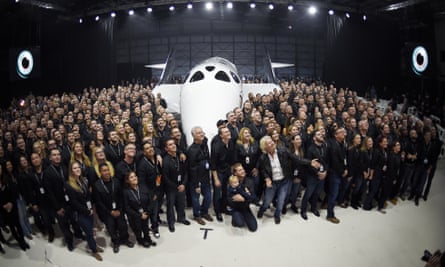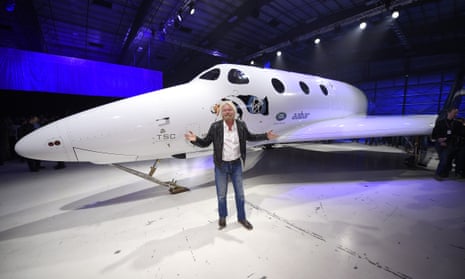Sixteen months after a tragic
crashduring a test flight which killed a pilot, aspiring commercial spaceflight company Virgin Galactic unveiled its newly built spaceship, VSS Unity, on Friday in a ceremony at the company’s factory in Mojave, California.
“It’s almost too good to be true, isn’t it?” said Sir Richard Branson, the founder of Virgin group, after the gleaming white and silver spacecraft was wheeled into the centre of the cavernous hangar. “I’ve always believed that having the best-looking planes and trains in the world, while not a guarantee, is a good place to start,” he joked, then paused. “Isn’t she beautiful?”
More than 700 people have signed up to fly on Virgin Galactic’s trips into space, which will be launched from SpacePort America, in New Mexico. The development and testing for the vehicle, however, has all taken place in Mojave, at the same airfield where Chuck Yeager became the first human being to break the sound barrier in his Bell X1.
The day, while jubilant in tone, was tinged with poignancy, Virgin Galactic’s CEO, George Whitesides, said in his introduction. He recalled meeting with Branson the day of the crash, in November 2014. “Years of hard work were put into doubt, and the life of a brave pilot was lost,” he said. Back then, the pair walked into the hangar, to where the new spaceship – Unity – sat, partially constructed. “And we wondered,” Whitesides said, “does this represent our past, or our future?”

Whiteside added that the whole team resolved, that day, to learn what they needed to learn from the tragedy, and stay true to their aim.
After a nine-month investigation, the National Transportation Safety Board ruled the 2014 crash to be the fault of pilot error, the result of unlocking the “feathering” system – designed to slow the craft down during re-entry – too early in the flight, and not due to any mechanical or systemic failure by the team.
Unity was officially christened by Richard Branson’s granddaughter Eva, who turned one year old the same day as the ceremony, using milk. Video tributes to the new spaceship came from Nobel laureate Malala Yousafzai and theoretical physicist professor Stephen Hawking, who also named the ship.
The craft is the first to be constructed by the Spaceship Company, Virgin Galactic’s in-house manufacturing arm; the last vehicle was made by an outside company, Scaled Composites.
However, Unity uses the same fundamental design as the first, Virgin Galactic’s executive vice-president of operations, Mike Moses, said. The biggest difference is a specially designed locking mechanism which would not allow the feathering to be activated except at the right time.
In an interview with the Guardian, Whitesides said that in the months since the accident, his team had “really been through the crucible”.

“The accident was a really hard blow, and the team has been working intensely for the last year to get to this point,” he continued.
“It’s tough when you know things are being said publicly that are not true,” Whitesides said, in reference to rumours that the accident might have been the fault of a badly calibrated rocket, or safety failings by the team. “And many of us were friends with Mike, the co-pilot who perished.”
The team have been cagey about making their predictive timeline public – saying that they want to give the safety testing as much time as necessary.
The testing phase – where Unity will be tested as a whole craft, first on the ground; then in tethered flight to the carrying aircraft; then in controlled glide; then finally in powered flight. “You’re talking about a couple of years, approximately,” Whitesides told the Guardian.
Asked what his long-term ambitions were, Branson told a room of reporters before the ceremony began that “first of all, it’s pretty cool to be taking people into space,” but said that the technology developed for space tourism would, he believed, prove useful for edge-of-space high-speed intercontinental travel. “A lot of people who work here are itching to start on that program,” he said.

Comments (…)
Sign in or create your Guardian account to join the discussion